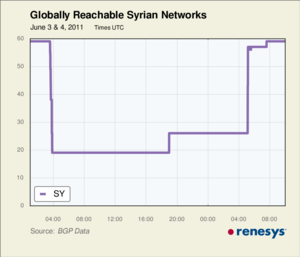On Friday, Syria joined the Arab Spring uprising trend of besieged government bureaucrats temporarily shutting down the Internet to try and mute protests.
The first news I saw on this was early in the day in my Twitter feed — but it wasn’t a tweet of a news story or someone quoting a news story or government official.
My news came from a tweet based on raw Google data.
In my feed, @BrianBoyer of the Chicago Tribune retweeted fellow Chicagoan (and Googler) @therealfitz with news that Syria had apparently gone dark, based on Google data — and that was two hours before Google itself officially tweeted about it.
[blackbirdpie url=”http://twitter.com/#!/brianboyer/status/76675449387880448″]
Google’s tweet:
[blackbirdpie url=”http://twitter.com/#!/google/status/76719765481197568″]
The source: Google’s Transparency Report, which shows near- real-time data for use of Google services by country/region and “visualizes disruptions in the free flow of information, whether it’s a government blocking information or a cable being cut.”
As the screen shot below shows, you can clearly see Syria falling off the Google system map — then coming back about 24 hours later.
Among the notations that Google added to its own chart was a status report from Renesys, a technology company that monitors global web traffic. In a blog post, it had noted at about 5:35 a.m. Syria time, “approximately two-thirds of all Syrian networks became unreachable from the global Internet. Over the course of roughly half an hour, the routes to 40 of 59 networks were withdrawn from the global routing table.” (Renesys blog RSS feed).
Here is the Renesys chart showing the take-down, and return:
Google’s traffic report page also keeps a running log of major downtime, by country, for its services, which is a good historic archive and secondary source for network watchers. In March, for example, you can find entries for Armenia, Georgia, Libya and Turkey.
You can check not only the overall status for countries, but also by individual Google services (e.g, You Tube, Blogger, GMail).
Google Transparency also includes country-by-country data about government “inquiries for information about users and requests for Google to take down or censor content.” The data is a little bit stale, only updated at this point thorough June, 2010. UPDATE ON 6/27: Data is now available through the end of 2010. Here is a country-by-country listing.
Know of other tools and resources? Drop me a line.
Veteran journalist Scott B. Anderson is a Medill lecturer specializing in interactive publishing. He also leads interactive strategy for the National Security Journalism Initiative, including overseeing, producing and reporting for NationalSecurityZone.org and its sibling interactive products.








